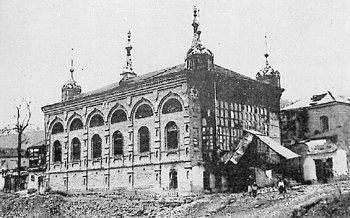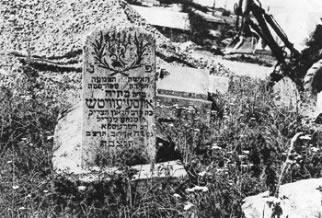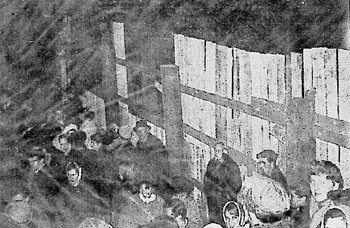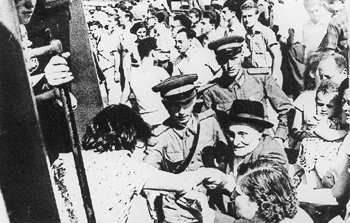Jews in the Soviet
Union from 1941
up to the end of the
Soviet era
(Part 4 of 8)
Assimilatory
Pressures
With the death of Stalin, the "Black Years" of Soviet Jewry have come to an end, but his successor Khrushchev allows only piecemeal reforms. In 1957, for the first time since the revolution, a Jewish theological seminary (yeshiva) opens again in Moscow. A number of amateur drama and music groups are re-established, and in 1959 Yiddish book publishing resumes after 11 years.


At your left,
the synagogue of Kuba (Azerbaidzhan) was turned into a textile factory in 1959.
At your right,
dozens of Jewish graveyards were expropriated and destroyed. Here, the Jewish
cemetery of Minsk is being bulldozed.
During the years of Stalin's suppression of Yiddish culture, a few synagogues had been allowed to go on functioning. In the last years of Khrushchev's leadership, however, a campaign of militant atheism is launched against all religions, particularly affecting Jewish institutions. Jewish cemeteries are expropriated and destroyed, and more than fifty synagogues are closed. In dozens of books, authors with Jewish-sounding names denounce the Jewish religion. Only an estimated sixty synagogues remain open in 1965.


At your left,
Jews of Leningrad celebrating Simcha Tora in 1964 in spite of the wooden barricade
closing off the synagogue.
At your right,
an elderly Jew welcomes Israeli participants to the 1957 International Youth
Festival in Moscow. As the first visitors from Israel since many years, they
were received with great enthusiasm.
During the same period, hundreds of trials against "economic crimes" like embezzlement and speculation are reported in the Soviet media. Mostly, the accused bear distinctly Jewish names, reviving the familiar stereotype of the Jew as a swindler and speculator.
Number and percentage of Jewish students at Moscow institutes of higher learning, 1970 - 1980. Many Jews experienced the invisible barrier of discrimination in the form of an unofficial numerus clausus.
University year Total
no. of students Jewish students
Jewish
students in % 1970-71 617,141 19,508 3.16 1974-75 627,285 14,985 2.39 1976-77 641,311 12,049 1.88 1978-79 632,037 11,531 1.82 1980-81 631,088 9,911 1.57 |
For Soviet Jews, all these
experiences seem to point in one direction only: to assimilate completely and
disappear as a distinct community. They are cut off from their language, and
their culture and religion are under constant attack. Furthermore, after the
wave of dismissals during the Stalin era, many fields of employment and advanced
studies have become effectively closed for Jews.